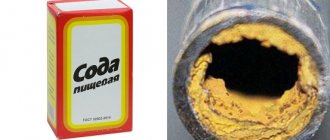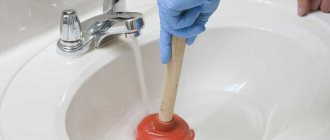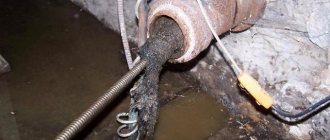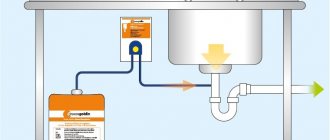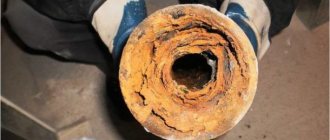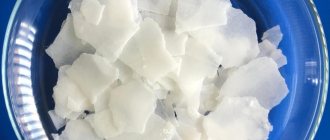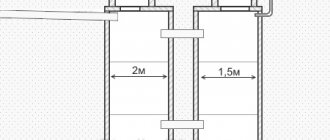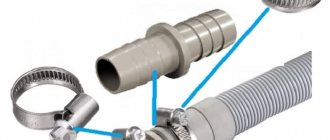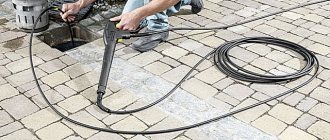Baking soda and vinegar don't help, what should I do?
It was already emphasized above that cleaning pipes with soda and vinegar will be effective only for minor fatty deposits, while removing high-density blockages will require a more serious approach. In this case, one of the following methods will help restore the sewer system:
Cleaning the siphon.
Thanks to its special design, the siphon not only serves as a kind of protection against the spread of unpleasant odors in the room, but also acts as a filter, collecting large objects and hair that fall into the sink. Very often, to clean the sewer system, it is enough to remove the accumulated debris from the siphon.
Use of plumbing cable.
Every homeowner should have such an item, which is a spiral-shaped wire with a handle and a drill at the ends. No chemical can remove a solid object that has fallen into the pipe. Mechanical blockage can only be removed mechanically.
Hydraulic sewer cleaning.
The most effective way to remove grease, dirt and debris from a pipeline is to flush the drain using high water pressure. A special cable with a nozzle at the end is lowered into the sewer hole, after which water pressure is applied, washing away everything in its path.
Of course, it is better to prevent the accumulation of dirt and grease in the pipe by carefully operating the sewer and carrying out preventive maintenance on time. If “trouble” does occur, then you can use the simple recipes given in this article and try to clear the clog in the sink, toilet or bathtub using soda and vinegar. In most situations, these actions will be enough to restore system functionality. If there is no positive result, you should contact professional plumbers to avoid further aggravating the problem.
Advantages and disadvantages of cleaning pipes with vinegar and soda
One of the main priorities of cleaning pipes with acid and soda is considered to be cost-effectiveness, accessibility and safety . Products are available in any supermarket. In addition, the cost is five or even six times cheaper compared to expensive cleaning products.
Baking soda and vinegar acts as an anti-rust agent against rust marks and stains. Therefore, it is considered a safe composition for any pipes, in contrast to aggressive chemicals.
The reason for the formation of scale in a washing machine is a large amount of calcium and magnesium salts in the water. To neutralize the harmful effects, add vinegar to the washing machine when washing. When heated, the acid interacts with harmful salts and prevents them from settling on the internal device.
Advantages of cleaning sewer pipes with a folk remedy:
- does not harm plastic and metal pipes;
- can eliminate not only fat accumulation, but also unpleasant odors;
- Suitable for cleaning sinks, kitchen sinks, bathtubs or shower stalls, and toilets.
There is only one drawback - soda and vinegar cannot cope with complex debris: hair, inorganic compounds. Therefore, more radical measures will be required - the use of aggressive cleaning agents.
Recommendations for preventing blockages
If the entry of foreign objects into the sewer most often comes as a surprise, then the appearance of blockages from siltation can be prevented 100%. If we summarize all the measures that can be taken to prevent blockages, the list will look like this:
- It is necessary to monitor the compliance of the sewerage system with the design parameters. If “wet” points (plumbing fixtures or kitchen sinks) are moved from the outlet of the sewer riser, special sanitary pumps designed specifically for such drains should be used.
- The sewer system is not designed to dispose of waste. Large objects can clog it. Personal hygiene products, rags, cleaning products and other food debris are not allowed to enter the drain. It is better to throw leftover food in a bucket rather than in the sink. Modern sinks are often equipped with built-in waste disposal units. It is very comfortable.
- When repairing and cleaning sewers, you should use professional products and tools. For example, polyethylene pipes can only be cleaned with soft synthetic brushes that will not scratch their inner surface. Any scratches, chips, transitions of complex geometry can become “thresholds” even for small debris. The clog can begin to grow like a crystal - from one grain stuck to the pipe.
- To avoid silting with fats, preventive maintenance should be carried out regularly. In principle, if you do this often, then simply pouring boiling water over the system is enough. Some experts say that, in theory, water that is too hot can burn through plastic pipes. But in practice, such experience has not been recorded. There are specialized products on sale that are designed to remove fatty deposits on pipes. They can be used as needed.
- There is a theory that says you shouldn't be obsessive about scrubbing your plates before washing them. It is believed that small insoluble food residues, like brushes, will knock off the grease settling on the walls, thereby cleaning the pipes.
Preventive methods using special equipment
According to specialist statistics, the most common cause of blockages is the “human factor”. These are randomly discarded large items. If the sewerage system is operated carefully, but still constantly gets clogged, there are most likely problems in the structure itself. You need to look at the construction diagrams and change the levels of nodes. In this case, it is even safer to install a sanitary pump. The device costs about 10 thousand rubles, but it is purchased once and solves the problem of blockages forever.
The proposed folk methods for getting rid of blockages in the riser and water supply will help you avoid major problems and financial costs associated with replacing the entire sewer system.
Preventing contamination in the toilet
Cleaning sanitary fixtures is a necessary but unpleasant procedure. You can avoid frequent surface contamination with limescale, urinary stone, and rust by following preventive measures. Proper handling of plumbing fixtures will help maintain the whiteness and shine of ceramic or earthenware coatings and prevent the formation of blockages in the drain pipe.
A few tips that will save you from constant cleaning of sanitary fixtures:
- Eliminate water leakage from the drain tank - a constant stream leaves a mark on the surface.
- Do not allow dirty water to stagnate - use the flush button after each visit to the bathroom.
- Do not throw out food waste - it leaves a greasy mark on the ceramics and causes blockages.
- Do not throw personal hygiene products into the bowl - use a trash can for this purpose.
- Constantly use a brush to remove organic debris from the body.
- The brush should not be dry - a mixture of water and cleaning agent is poured into the flask where it stands.
- Be sure to use water softening substances - put special tablets in the drain tank or attach devices under the rim.
Preventive measures will eliminate the need for frequent cleaning of the surface and extend the life of the sanitary fixture.
Methods for cleaning pipes using other means
There are other cleaning methods using folk remedies, but their effectiveness is slightly less than that of soda and vinegar for cleaning pipes.
- Cleaning pipes using table salt and baking soda. You need to take half a glass of salt and soda, pouring them into the drain hole. Then pour boiling water and leave for eight to ten hours; during this time you cannot use the sewer drain.
- Using soda and citric acid. That is, all the above actions (see the section “how to clean pipes with soda and vinegar”), only instead of vinegar, citric acid is used to clear the blockage.
- Use only baking soda. You need to pour a glass of dry powder into the drain and then pour one liter of boiling water. After an hour, rinse the drain with water.
It is worth remembering that you cannot use improvised means immediately after clearing drains of blockages with chemicals purchased in a store, since their interaction can result in the formation of toxic compounds, the fumes of which are harmful to human health.
Handy toilet cleaning products
The toilet requires thorough cleaning at least once a week.
In order to maintain cleanliness, it is necessary to use an abrasive sponge soaked in warm water and powder. Vinegar cleaning is used to remove limescale deposits. You can use any vinegar (including apple cider vinegar). Before use, vinegar is heated, poured into the toilet and iodine and soda are added. Leave for three hours and then wash off.
Application of Whiteness. Remove the water from the toilet and pour one bottle of white into it, leave it overnight, and rinse with water.
Removing plaque and stones using citric acid. Pour two or three sachets of citric acid into the toilet, leave for several hours, and flush.
To get rid of very strong stains, use oxalic acid, which is poured into the toilet for several hours, and then cleaned with a brush and rinsed with water.
Coca-Cola does an excellent job of removing deep-seated dirt, urinary stones and limescale. Several bottles of the drink are poured into the toilet, left for four hours, and then flushed with water using a brush.
Reviews
My mother advised me how to clean the drain with soda and vinegar, and I’m not very happy with the result: a small blockage broke through in the bathroom and toilet, and the dirt plug in the kitchen never went away, so I had to call a plumber. I think that for not very severe blockages, the method is not bad, and it is quite possible to clean the pipes with soda and vinegar.
I learned about cleaning sewer pipes with acetic acid and soda from an old book “Household Economics”. I tried it, it didn’t work the first time, but after the third treatment the water began to go away wonderfully! I’m happy, now I regularly add baking soda and vinegar as preventive measures, so far there are no problems with the pipes.
I am a single mother, so I decide all issues myself. I read on the Internet how to clean the sink with soda and vinegar. It turned out well, no blockages, no smell. I recommend this simple and very accessible method to everyone.
Source
Why is baking soda and vinegar chemically based?
Due to their chemical properties, alkalis perfectly dissolve dirt, grease and protein, therefore they are the basis of most chemicals intended for cleaning clogs. Many classify baking soda (sodium bicarbonate) as an alkali, arguing that it is neutralized by vinegar in the same way as any alkali is neutralized by acid. On the other hand, there are many people who will argue with this statement, focusing on the formula of sodium bicarbonate - NaHCO₃, from which it follows that baking soda is an acidic salt. To find the truth in this dispute, let's turn to the school chemistry course.
Sometimes salts whose solutions have a pronounced alkaline reaction (sodium bicarbonate solution has a pH of 9) are classified as alkalis. Therefore, both those who logically consider NaHCO₃ to be salt and those who classify baking soda as an alkaline environment are right.
To clean the walls of sewer pipes from small deposits, soda can be used without additional components, adding only water. However, to increase the effect, sodium bicarbonate is neutralized with acetic acid, resulting in a violent reaction with the formation of sodium acetate and intense release of carbon dioxide. The chemical formula for this transformation looks like this:
NaHCO₃+CH₃COOH->CH₃COONa+H2O+CO2
A sodium acetate solution has the same pH as a bicarbonate solution, so it has a similar effect on dirt and grease. At the same time, the intense release of carbon dioxide molecules contributes to an increase in pressure inside the pipeline and, as a result, faster destruction of fat plugs.
Useful tips
A fairly simple method of cleaning pipes and plumbing from dirt and grease can become even easier if you use the following tips:
- It is better to treat drain systems before going to bed or leaving for work, pouring a solution of vinegar and soda into the pipes for a longer period.
- It is strictly forbidden to treat plumbing fixtures and pipes with chemicals together with soda and vinegar. As a result, toxic compounds hazardous to human health may arise.
- Table vinegar can be replaced with wine vinegar. It has a lower concentration and is slightly less effective in combating blockages, but copes well with greasy and oily deposits.
When it comes to preventing blockages, the main thing is regularity. Timely prevention and quick response to the slightest signs of pipe obstruction will certainly reduce the risk of a large-scale domestic disaster. And using soda and vinegar for cleaning will make the process safe and affordable.
Source
What other compositions can be used
If a sewer pipe in the kitchen or bathroom is clogged at home, you can clean it with a slightly different composition, which contains soda. To create a sufficiently suitable ingredient you will need half a package of baking soda and the same amount of salt. Mix these products together and pour them down the drain, add hot water and leave for eight hours. It is advisable not to use the sewer at this time; therefore, removing the blockage should be done at night.
After the time has elapsed, open the line with cold water and check how it flows into the drain; when it is slow, you will have to use a plunger to clean the dissolved debris plug. This product is suitable for plastic and metal pipes. It can be used both for prevention purposes and to eliminate the problem. These methods will help solve other issues besides unclogging the kitchen sink.
You also use 1 cup of soda, pour it down the drain, then fill it with hot water and leave for about 40 minutes. Then simply wash off the composition in the pipe with plain water. If the plug of dirt that is clogged is small, then this method will be no less effective, otherwise it will be necessary to clean the system several times.
- Boiler room at home ► The gas water heater does not light up: the main causes of water heater failure and how to eliminate them
- Boiler room at home ► What to do if the sink is clogged? — methods of elimination and preventive measures to prevent contamination
- Boiler room at home ► Water flows from the tank into the toilet: the main causes of breakdowns and how to fix them yourself
- Boiler room at home ► Why the pumping station often turns on: reasons for equipment failure and ways to eliminate them
- Boiler room at home ► Choosing cables for cleaning sewer pipes, or how to clear the blockage yourself
- Boiler room at home ► Features of installing a pipeline from steel pipes, connection methods
- Boiler room at home ► Do-it-yourself polypropylene water supply: advantages of PP pipes, selection of parts, wiring methods, installation work
- Boiler room at home ► How to clean a sewer in a private house - cleaning methods and their features
- Boiler room at home ► The cesspool has silted up - what to do? Signs of siltation and cleaning methods
- Boiler room at home ► Replacing pipes in the bathroom
- Boiler room at home ► What to do and how to avoid blockages in sewer pipes and quickly clear the blockage in the sewer
- Boiler room at home ► Methods of water supply
- Boiler room at home ► How to drill a well with your own hands: types of wells and drilling methods
- Boiler room at home ► Laying out pipes in the bathroom with your own hands - developing a diagram, choosing a method for laying a water supply system, dismantling used pipes
- Boiler room at home ► SODA
SODA, see Sodium carbonate. Heating water supply boiler room LLC DESIGN PRESTIGE > https://resant.ru/ Telephone: 8(495)744-67-74 We provide installation services for heating and water supply systems for private country houses, dachas, organizations. We supply......
- Boiler room at home ► Sodium hydroxide (Sodium hydroxide, Caustic soda, Caustic soda)
Substance: Sodium hydroxide (Sodium hydroxide, sodium hydroxide, caustic soda) Code: 150 Ag. comp.: solidHazard class: 150 MPC s/s: n/dPK m/r: n/dBOV: 0.01 VOC: no Heating water supply boiler room LLC DESIGN PRESTIGE > https://resant.ru/……
- Boiler room at home ► Emulsol (mixture: water - 97.6%. sodium nitrite - 0.2%. soda ash - 0.2%. mineral oil - 2%)
- Boiler room at home ► diSodium carbonate (Sodium carbonate, Soda ash)
Substance: diSodium carbonate (Sodium carbonate, Soda ash) Code: 155 Ag. comp.: liquid/gas Hazard class: 155 MPC s/s: n/dMPK m/r: n/dOBV: 0.04 VOC: no Heating water supply boiler room DESIGN PRESTIGE LLC > https://resant.ru/ Telephone……
- Boiler room at home ► Methods for dismantling concrete
- Boiler room at home ► Methods of water supply at home
Briefly about the formation of blockages
During operation, liquid consisting of water, soap, shampoo and other personal hygiene products is washed down the drain. This greasy composition settles on the walls of the sewer outlet.
In addition, hair, animal hair, debris, lint from carpets or rugs, and other small particles penetrate the pipe. They stick to soap scum. Gradually, the layer of dirt grows, reducing the throughput of the drainage equipment.
If you do not clear the blockages in time, the plug will completely close the drain and water will stop flowing into the sewer.
If your bathroom pipes become clogged too often, you need to figure out why. There may be several of them:
- Improper use of plumbing equipment. Do not wash clothes that are too dirty in the bathtub. For example, rugs and carpets that have not been cleared of sand or dust. Bathing pets without first brushing out loose hair is also prohibited.
- Incorrect installation of plumbing equipment, i.e. insufficient slope of sewer pipes, as well as the presence of excessive bends that reduce the speed of water flow.
- Wear of drain channels (rust, holes).
Do-it-yourself removal of clogs
The tools that every housewife has in her kitchen can be excellent helpers if the sewer line is clogged. The substance, which contains soda and vinegar, is considered harmless both to humans and to the drainage system, especially since it is very simple to make. If water does not flow out of the hole, then the system is clogged, so we proceed as follows:
- We prepare the necessary components to create an effective product. You will need soda, vinegar, hot water (preferably boiling water), a soft but thick rag, and a plastic stopper will also work to clog the drain;
- We wash the sink: you can use soda, you can use regular dishwashing detergent. Afterwards we wipe it dry;
- we remove the siphon from the device and also clean it well; if there is water and dirt, we remove them and install the device in the sewer;
- Take baking soda and pour half a packet directly down the drain, then measure the vinegar into a measuring cup. For these purposes, 100 ml is enough, and pour the liquid after the soda;
- cover the sewer hole with a rag or existing plug. This is done so that foam does not rise from the pipe if the components react;
- We wait 30-40 minutes, and then prepare boiling water. Open the drain and pour the entire kettle of water into it. Do this gradually so that the liquid does not go beyond the drain hole;
- Now we try to open the valve and start the water supply. After the procedure, the water should drain at an accelerated pace.
Now you know how to remove a clog in the sink correctly; this consistency is also ideal for using to prevent fat deposits.
How to clear a clog in the bathroom
A clog occurs in the bathroom due to hair and animal fur. Such waste does not decompose naturally, so it is more difficult to remove the waste. If the sewer pipe is severely clogged, an effective method is used to remove the blockage. The method is effective, but unsafe.
How to properly clean pipes:
- For safety reasons, open the windows.
- Pour 50 g of soda ash and baking soda into the drain hole.
- After 30 minutes, pour 150 g of acetic acid and “Whiteness”, plug the hole with a rag or cork. Leave the premises. The interaction reaction will release harmful substances into the air for the respiratory organs.
- After 30 minutes, fill the sewer pipe with plenty of running water.
- Finally, ventilate the room.
Explosive mixture - soda ash and baking soda with vinegar
Recipe 3
Vinegar and baking soda do not have to be used together for drain cleaning. For example, this recipe involves using only baking soda. Another component is also taken - salt. Ordinary table salt has good effectiveness against various types of contaminants, and therefore it can also be used to solve the painful problem of clogged household drains.
The recipe is as simple as possible - you need to take half a glass of salt and soda and pour them into the pipe. This can be done one by one, or by first mixing both components in one glass. Next, immediately pour in hot water, about two to three liters. It is advisable to do this overnight, as you will need to leave everything as is for at least eight hours. Be sure to make sure that nothing, not even clean water, is poured into the pipe for the entire time that the soda and salt are in effect.
There is also a separate effective method that answers the question of how to clear a clog if it has formed in the sink. The method is also based on the use of vinegar and soda, which once again demonstrates the effectiveness of these substances.
Here's what to do:
First thoroughly clean the sink. It is necessary to remove all accessible contaminants and then wipe the surface dry; take half a glass of baking soda and pour it down the drain
It is important to ensure that all the substance gets inside. If soda lingers on the surface of the sink, force it back in using any suitable available tools, for example, a regular cotton swab; then pour a similar amount of vinegar into the drain hole; there is no need to close anything, as in the case of cleaning pipes - after a few minutes you can pour hot boiled water down the drain; the final stage is rinsing with plenty of running water
You can open either a cold or a hot tap - there is not much difference. You need to rinse until the water begins to flow into the hole as expected, that is, without any delays.
Now you know how to clean pipes with soda and vinegar. As you can see, there is nothing complicated here. Almost all effective methods are based on the need to fall asleep and pour substances into the pipe or sink drain
Even though vinegar and baking soda are considered mild chemicals, some caution must be exercised when working with them. Be careful not to get them in your eyes
Try not to breathe in the substance formed as a result of the chemical reaction between soda and vinegar - it is not entirely safe. It is also recommended to wear gloves.
It is always much easier, cheaper and faster to prevent a problem than to fix it later. The blockages can be very dense and large, and in such cases the help of improvised means, which include soda and vinegar, may be limited. Therefore, there is a possibility that you will have to go to the store and buy expensive household chemicals. And all because you didn’t clean the sewer in time. It is highly recommended to resort to this activity at least once every few months. Simply add baking soda or vinegar to your drains, fill them with hot water, and enjoy functional, trouble-free household drainage for many years to come.
How to unclog a bathroom drain
A clogged bathroom drain is identified by an unpleasant odor and water does not drain well. If the plunger does not help to break through the plug, use the following composition:
- 200 g baking soda;
- 200 ml vinegar;
- 3 liters of hot water;
- a rag to cover the hole.
You can also use this mixture to clean your oven. The only thing is not to add water. Simply prepare the product, then treat the surface. The main thing is to know how to clean the oven with vinegar and soda.
This composition produces a lot of foam, so it is most suitable for the bathroom. The splashes will remain on the walls, but not on the floor; you won’t have to clean up.
It is a misconception that vinegar and soda dissolve organic compounds. When substances interact, carbon dioxide is released, which creates strong pressure in the pipe. On the one hand, the rag will not allow the gas to escape; on the other hand, it puts pressure on the clog and pushes it further into the sewer.
If there is no vinegar, you can use salt: at the rate of ½ cup salt and soda, ¼ cream of tartar.
Cleaning carpets with vinegar and salt will help remove old greasy stains without disturbing the fiber structure. You can also update the coverings on upholstered furniture.
Watch the video on how to unclog your sink
Chemicals
Household chemicals will help remove the blockage. On store shelves there is a wide range of products designed to restore normal operation of the pipeline. They are available in the form of powders, gels or liquids.
The preparations contain aggressive substances that can dissolve any contaminants. Among the effective cleaning products are the following: Sanfor, Tiret, Sanox, Mole, Chirton, Mister Muscle and others.
Rules for cleaning pipes in a bathtub with chemicals:
- Read the instructions for use.
- Take the recommended safety measures - wear gloves, a respirator, turn on the hood or open the door and windows.
- Pour or pour the selected product into the drain hole and leave for the time specified in the instructions.
- Flush the pipes with plenty of hot water to restore normal flow.
Household chemicals will help you deal with clogs of any complexity. Please read the instructions for use before use.
Citric acid and soda for cleaning pipes
Vinegar can be replaced with a solution of citric acid. As a result, the same reaction will occur as with soda.
Cleaning process:
- Pour half a pack of baking soda into the drain hole.
- Dilute citric acid in a glass of water and pour it there.
- Leave the product in the hole for 1 hour, then rinse with hot water.
Citric acid is also used to descale washing machines. It is enough to carry out the procedure once every 3 months. Many housewives consider table vinegar to be the best remedy; the main thing is to know how to descale a washing machine.
Causes of clogged home drains
There are several reasons for the breakdown of the sewer system, which are somehow related to the human factor:
- deposition of fat and organic substances on the internal walls of the sewer;
- accumulation of large debris in the pipe (food debris, hair, toilet paper, etc.);
- incorrect pipeline location (for example, low slope);
- overflow of a septic tank or cesspool (for private houses).
Compliance with the rules for design, installation and operation of sewerage will help prevent the occurrence of such situations. Many people assume that the pipe connected to the sink can absorb any food, without thinking that its capacity is limited. Therefore, dishes often end up in the sink along with large leftover food. Preventative cleaning of the system is done extremely rarely, despite the simplicity of this procedure (it is enough to open the hot water tap for 10-15 minutes once a week).
Of course, cleaning the drain with soda and vinegar is not a panacea for all ills, since serious blockages can only be removed using mechanical or hydraulic methods. However, it is quite possible to remove fat deposits with such a solution. At least it’s worth a try, especially since the costs in this case will be minimal compared to purchasing expensive chemicals.
Causes of blockages
Blockages in sewer pipes are a fairly common occurrence. There may be several reasons for this:
- Lack of slope of the sewer circuit towards the riser or, conversely, its redundancy, excessive tortuosity.
- Accumulation of fat and dirt insoluble deposits on the inner walls of pipes. Small debris is subsequently layered on it. This leads to a gradual narrowing of the passage opening, completely blocking the sewer flow and requires careful cleaning.
- The same effect occurs due to poor water quality. The minerals included in its composition form a limescale deposit, which only thickens over time.
- Particles of earth and sand washed from shoes into the sink, or foreign objects and household waste entering sewer pipes from a toilet or bathtub, accumulate in the recesses and cling to the joint elements, preventing the free passage of drains.
- Poor condition of the pipeline. Roughness of the walls, corrosion of cast iron pipes or careless installation of joints (fracture, protrusion of O-rings, tow) leads to the formation of irregularities in the internal circuit.
Mechanical methods
Mechanical cleaning will help get rid of blockages in the bathtub. To carry it out, use a plunger or cable, and to achieve maximum effect, additionally use household chemicals or folk remedies.
plunger
Cleaning procedure:
- Place the plunger directly above the drain hole. (To ensure a tight seal on the rubber tip, lubricate it with Vaseline.)
- Make forward movements, sharply moving the handle of the plunger up and down. Under the influence of hydraulic shocks, the plug passes into a wide sewer pipe or exits through the drain hole.
- After removing the dirt, pour hot water into the bath and repeat the procedure again. This is guaranteed to get rid of the densest plug and effectively clean the drain.
An effective way to unclog a bathtub, sink or toilet is to use a plunger. The tool is easy to use, yet effectively copes with the task.
Cable
If the plunger does not cope with the task or is simply not at hand, use a cable.
Cleaning technology:
- Take a thick flexible wire or a special plumbing cable.
- Make a small hook on one side and wrap the fabric on the other, creating an impromptu handle.
- Carefully push the cable into the sewer, breaking through the plug.
- Pull out the hook, removing any remaining dirt. Flush the pipeline with plenty of hot water.
Siphon cleaning
The siphon can also become clogged, which also needs to be cleaned periodically.
Cleaning algorithm:
- Place a container under the siphon to collect water and lay down floor rags.
- Remove the fasteners and flask.
- Drain the water from the siphon and remove all dirt. Rinse the part with running water.
- Reinstall the siphon and check for leaks at the mounting points.
To normalize the drain, periodically clean and wash the siphon well. After the procedure, check that the installation of the part was carried out correctly and there are no leaks
Causes of clogged sewer drains
As a result of active use, the clearance of sewer pipes decreases, which prevents the normal outflow of water.
The reasons for this phenomenon are the settling of detergents, grease and food residues on the inner surface of the pipes. If the pipes are not properly maintained, dirt can completely block the lumen. Moreover, the accumulation of sediment on the walls is possible in both metal and plastic pipes. Most often, such blockages occur under the sink in the kitchen, and a little less often in the bathroom.
The cause of a blockage in the toilet drain may be objects that have gotten into it (hygiene items, diapers, etc.) that do not dissolve in water and completely block the drain. Complex blockages in toilet drains are cleared with the help of cables and specialist plumbers.
Cleaning with soda and vinegar
The appearance of an unpleasant odor near the sink or bathtub or the slow suction of water into the sewer are some of the first signals that it is time to clean the pipes, without waiting for a more global blockage that can completely block the lumen of the drain pipe.
It is possible to clean the sewer using the simplest means at hand, which can be found in any kitchen, without purchasing special powders and solutions. Baking soda and table vinegar do an excellent job of removing various contaminants.
Before starting cleaning work, it is advisable to wash and clean all siphons under the bathtub and sink. After all, it is in siphons that pieces of food, fat, and so on are collected; in addition, siphons are designed to prevent foreign odors from entering the room from the sewer.
After cleaning the siphons, you need to prepare the ingredients for cleaning the pipes:
- vinegar is taken at the rate of one hundred milliliters per drain;
- soda you need to take half the package for one drain hole;
- cloth with which you can plug the drain;
- boiling water (it’s more convenient to use from a kettle);
- rubber gloves to protect the skin of your hands and safety glasses.
After preparing everything you need, you can start cleaning the pipes with soda and vinegar:
- Pour half a pack of baking soda into the clogged drain hole; the soda must be dry; there is no need to dilute it with water or other liquids.
- After baking soda, pour one hundred milliliters of table vinegar into the hole; for the best effect, it is recommended to slightly warm the container with vinegar in hot water or in the microwave.
- Then quickly and tightly seal the hole with the previously prepared cloth so that the reaction between soda and vinegar occurs inside the clogged pipe and not outside.
- We leave the drain plugged for thirty minutes so that the reaction that occurs completely dissolves the sediment. During this time, you need to boil water in the kettle.
- After half an hour, take out the rag and slowly pour boiling water into the drain hole in a thin stream.
- If, after all the manipulations performed, the water still does not drain well through the drain, we repeat the procedure.
What to do if there is a clog in the toilet
Toilet drains often become clogged with toilet paper, napkins, and personal hygiene products. To clean, take 400 ml of table vinegar and 0.5 packs of baking soda.
Step-by-step instructions for cleaning the drain hole:
- Pour baking soda down the drain and add acetic acid.
- Use a brush to clean the surface of the toilet.
- Close the lid and leave the product for 30 minutes.
- Scrub the toilet again with a brush and rinse with running water.
More dense congestions can be removed using the following composition: 5 tbsp. l. baking soda and the same amount of soda ash.
Cleaning process:
- Mix both reagents and pour into the drain hole.
- After 30 minutes, treat the surface of the toilet with vinegar, pour 100 ml of acid down the drain and close the lid.
- After half an hour, clean with a brush and rinse well with running water.
How to clear a clogged sink with baking soda and vinegar
Clogs in the kitchen are common. Calling a plumber for such a trifle is pointless, and fixing the “trouble” yourself is troublesome and gives poor results. A popular “grandmother’s” recipe, known to many housewives since Soviet times, will help to effectively clear a clog in the sink.
As a rule, the cause of a clog in the sink is the accumulation of dirt particles that form a “plug” that prevents water from leaving. You can break through it using a simple chemical reaction that occurs directly in the drain.
You will need regular baking soda. Its quantity will depend on the degree of contamination: from 4 tbsp. up to 1/2 pack. The amount of vinegar will be calculated based on the amount of soda: 70% vinegar essence will be required 2 times more than sodium bicarbonate.
We provided detailed advice on the problem in the article “soda and vinegar for cleaning pipes.”
Before starting work, be sure to wipe the surface of the sink so that it is dry.
To clear the blockage, you must:
- Pour soda powder into the drain and pour in the vinegar solution. Plug the sink drain hole with a rag or stopper - during the reaction, a large amount of foam is formed, and if the hole is not plugged, it will “crawl” out.
- Wait an hour. If you want to completely remove the traffic jam, it is better to increase the waiting time by 1-1.5 hours.
- Take out the rag and pour hot water into the cleaning area. The best option would be to “rinse” for 3-5 minutes.
In this case, the gas formed during the reaction helps remove the “plug”. It seems to “press” the clogged area, simultaneously clearing deposits on the walls of the siphon.
The second way to quickly clear the clog is to prepare a soda solution:
- Boil 1-1.5 liters. water. Pour boiling water into the drain hole - this is necessary to wash out fine dirt.
- Boil 3 tablespoons of water. Add 1 cup of baking soda to them and mix thoroughly.
- Drain the solution into the sink. Repeat the procedure if necessary. The volume of the solution can be increased in a ratio of 1:3.
When getting rid of clogs using baking soda and vinegar, the main thing is to follow safety precautions. Always use rubber gloves and avoid contact of cleaning agents with unprotected skin and mucous membranes.
How to clean a bathtub with soda and vinegar - read the next article.
Use such solutions only in well-ventilated areas, and be sure to rinse the sink with plenty of warm water after cleaning the drain.
How to clean a sewer pipe
The best solution for cleaning sewer pipes is caustic soda. Toxic substance requires careful handling.
Author's note
Kirilova Olga
Use rubber gloves, safety glasses, and rubberized clothing. If the product gets on the skin, rinse with water and lubricate with a weak solution of boric acid.
Prepare:
- 2 kg caustic soda;
- plastic bucket with a capacity of 10 l;
- scoop.
Instructions for use:
- Pour the caustic into a bucket and fill halfway with water.
- Mix the mixture carefully; the powder will heat up as it dissolves.
- Pour the resulting product down the drain.
- Do not use the sewer for three hours.
- Flush the drain hole with water for 15 minutes.
Author's note
Kirilova Olga
Do not use caustic soda frequently; the aggressive powder will corrode even durable coatings.
Caustic soda is diluted with water
Cleaning sewer pipes with baking soda and vinegar
The violent reaction of vinegar with soda ash pushes clogs out of sewer pipes. We'll tell you in detail how to quickly clear stagnation.
Required components:
- 100 g soda;
- liter 9 percent.
How to clean:
- Pour baking soda into the hole.
- Pour in acid.
- Place a plug to seal it.
The cleaning method is suitable for mild obstructions or the process must be repeated until complete clearance.
Vinegar is safe for products made of alloys. See how to clean the inside of an iron with vinegar at home. And your iron will be like new.
Cleaning drains with soda and vinegar in a private home
In the private sector, pollution of the sewer system occurs more often. There are 4 types of sewer clogs:
- Biological – accumulation of food and household waste.
- Operational - fatty deposits are mixed with foreign particles.
- Mechanical – foreign objects enter during use of plumbing fixtures.
- Technical – poor design and assembly of pipes.
There are different cleaning methods for the listed contaminants. Calcined with acid can rid the system of contamination if the plug is of a biological or operational nature.
Required components:
- 1 part soda;
- 1 part water;
- 1 part 70% essence.
How to clean:
- Dilute with calcined water.
- Pour into the pipe.
- Immediately pour 70% acid (wear gloves and a respirator).
- Install a plug made from scrap material.
- After 25 -30 minutes. rinse with hot water.
- If the clog still remains, repeat the process from the beginning.
Do not forget to be careful when using acid; if it gets on your skin, it will cause burns.
Do-it-yourself plumbing cable for clearing clogs
Methods for cleaning pipes with step-by-step instructions
There are several ways to clean drains using baking soda and vinegar. Let's look at each option in detail.
Removing clogs using soda and boiling water ↑
If the water in the sink does not drain as quickly as before, and there is no major blockage, you can resort to the following method:
- Pour 200-250 ml of sodium bicarbonate into the drain hole, making sure that the powder is completely inside the pipe.
- Add 600-700 ml of hot water to the drain (proportion 1:3).
- If the effect is insufficient, repeat the procedure after a short period of time.
This simple method of cleaning drains is also recommended for use as a preventive measure. With its help, you can not only remove fatty deposits, but also disinfect the pipe.
Adding vinegar to enhance the effect ↑
As already noted, vinegar, as an acid, causes a violent reaction when interacting with soda, which contributes to better pipe cleaning. To implement this method you need:
- Prepare two containers with baking soda and a 9 percent vinegar solution in a 1:1 ratio.
- First pour alkaline powder into the drain hole, then pour in acetic acid.
- Wait until the reaction stops completely. Depending on the amount of ingredients, the process can take from 5 minutes to half an hour.
- Rinse the pipe with warm water.
This method is suitable not only for the sink, but also for cleaning the toilet - soda and vinegar perfectly dissolve fecal matter, toilet paper and many food products.
Increasing the pH of the solution ↑
For severe blockages, the options proposed above may not be effective enough due to the weak alkaline reaction. In this case, it is worth trying to use a solution of soda ash (sodium carbonate) with a higher pH value. However, you do not need to buy this mixture, since it can be prepared at home. To do this you need:
- Sprinkle 5 tablespoons (150 g) of baking soda into the pan and turn the heat on.
At a temperature of 60-200 °C, the reaction of bicarbonate decomposition into sodium carbonate, water and carbon dioxide will begin. After the water and carbon dioxide have completely evaporated (the powder will become more flowable), only soda ash (Na₂CO₃) will remain in the pan. Pour the resulting powder into 200 ml of water and stir until it is completely dissolved. Pour the solution into the pipe that needs cleaning and wait 2 hours. Rinse the drain with warm water.
Caustic soda against blockages
This product is not available in every home. They rarely buy it unless absolutely necessary. But if it is available, it will be useful for clearing the blockage.
Recommended for you:
How to clean white sneakers and light-colored shoes with baking soda at home
You will need:
- caustic soda (2-4 kg);
- water (5-7 l);
- durable plastic bucket;
- plastic spatula or scoop;
- latex or rubber gloves.
Cleaning process:
- Wear gloves.
- Using a spatula, pour caustic soda into the bucket.
- Fill with water, stir. The crystals should completely dissolve.
- Pour the mixture into the pipe.
During mixing, a chemical reaction occurs, the liquid heats up to approximately 60-70 degrees. This can be intimidating for some people the first time. But believe me, such a reaction is absolutely normal.
